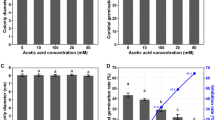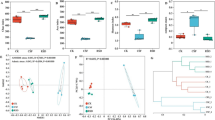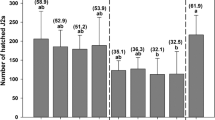Abstract
Soil sterilization integrated with agronomic measures is an effective method to reduce soilborne replant diseases. However, the effect of vermicompost or biochar application after soil sterilization on soilborne diseases is poorly understood. A pot experiment was conducted in American ginseng to investigate the effects of vermicompost (VF), biochar (BF), and a combination of vermicompost and biochar (VBF) applied after soil sterilization on the incidence of Fusarium root rot using natural recovery (F) as control. After one growing season, the disease index of root rot, the phenolic acids, and the microbial communities of American ginseng rhizosphere soil were analyzed. The disease index of VF, BF, and VBF decreased by 33.32%, 19.03%, and 80.96%, respectively, compared with F. The highest bacterial richness and diversity were observed in the rhizosphere soil of VBF. Besides, VF and VBF significantly increased the relative abundance of beneficial bacteria (Pseudomonas, Lysobacter, and Chryseolinea) in the rhizosphere soil. Higher concentrations of vanillin, one of the phenolic acids in the roots exudates, were recorded in the rhizosphere soils of BF and VBF. The vanillin concentration showed a significant negative correlation with the disease index. To conclude, vermicompost improved the beneficial bacteria of the rhizosphere soil, while biochar regulated the allelopathic effect of the phenolic acids. The study proposes a combined application of biochar and vermicompost to the rhizosphere soil to control Fusarium root rot of replanted American ginseng effectively.
Key points
-
Vermicompost improves the relative abundance of rhizosphere beneficial bacteria.
-
Biochar inhibits the degradation of phenolic acids by adsorption.
-
The combination of vermicompost and biochar enhances the disease control effect.






Similar content being viewed by others
Data availability
Raw data are available upon request.
References
Aimé S, Alabouvette C, Steinberg C, Olivain C (2013) The endophytic strain Fusarium oxysporum Fo47: a good candidate for priming the defense responses in tomato roots. MPMI 26(8):918–926. https://doi.org/10.1094/MPMI-12-12-0290-R
Antal MJ, Grønli M (2003) The art, science, and technology of charcoal production. Ind Eng Chem Res 42(8):1619–1640. https://doi.org/10.1021/ie0207919
Badri DV, Chaparro JM, Zhang R, Shen Q, Vivanco JM (2013) Application of natural blends of phytochemicals derived from the root exudates of Arabidopsis to the soil reveal that phenolic-related compounds predominantly modulate the soil microbiome. J Biol Chem 288(7):4502–4512. https://doi.org/10.1074/jbc.M112.433300
Bakker MG, Chaparro JM, Manter DK, Vivanco JM (2015) Impacts of bulk soil microbial community structure on rhizosphere microbiomes of Zea mays. Plant Soil 392(1-2):115–126. https://doi.org/10.1007/s11104-015-2446-0
Barder G, Compant S, Vescio BM, Trognitz F, Ma LJ, Sessitsch A (2017) Ecology and genomic insights into plant-pathogenic and nonpathogenic endophytes. Annu Rev Phytopathol 55:61–83. https://doi.org/10.1146/annurev-phyto-080516-035641
Berendsen RL, Pieterse CM, Bakker PA (2012) The rhizosphere microbiome and plant health. Trends Plant Sci 17(8):478–486. https://doi.org/10.1016/j.tplants.2012.04.001
Bi W, Chen J, Jiao XL, Gao WW (2011) Identification of the pathogens causing the root rot and their pathogenicity on American ginseng in Beijing. Plant Protection 37(5):135–138. https://doi.org/10.3969/j.issn.0529-1542.2011.05.025
Bi YM, Jiao XL, Li XX, Tian GL, Li L, Liu LH, Gao WW (2020) Degradation dynamics of nine phenolic acids in American ginseng and maize grown soils. Allelopathy J 49(1):73–88. https://doi.org/10.26651/allelo.j/2020-49-1-1255
Blum U (1998) Effects of microbial utilization of phenolic acids and their phenolic acid breakdown products on allelopathic interaction. J Chem Ecol 24(4):685–708. https://doi.org/10.1023/A:1022394203540
Cha JY, Han S, Hong HJ, Cho H, Kim D, Kwon Y, Kwon SK, Crüsemann M, Bok Lee Y, Kim JF, Giaever G, Nislow C, Moore BS, Thomashow LS, Weller DM, Kwak Y-S (2016) Microbial and biochemical basis of a Fusarium wilt-suppressive soil. ISME J 10(1):119–129. https://doi.org/10.1038/ismej.2015.95
Chaparro JM, Badri DV, Bakker MG, Sugiyama A, Manter DK, Vivanco JM (2013) Root exudation of phytochemicals in Arabidopsis follows specific patterns that are developmentally programmed and correlate with soil microbial functions. PLoS One 8(2):e55731. https://doi.org/10.1371/journal.pone.0055731
Chen YX, Zhang YF, Zhang QG, Xu LX, Li R, Luo XP, Zhang X, Tong J (2015) Earthworms modify microbial community structure and accelerate maize stover decomposition during vermicomposting. Environ Sci Pollut Res 22(21):17161–17170. https://doi.org/10.1007/s11356-015-4955
Dong L, Xu J, Zhang L, Yang J, Liao B, Li X, Chen S (2017) High-throughput sequencing technology reveals that continuous cropping of American ginseng results in changes in the microbial community in arable soil. Chin Med 12:18. https://doi.org/10.1186/s13020-017-0139-8
Duffy JE, Godwin CM, Cardinale BJ (2017) Biodiversity effects in the wild are common and as strong as key drivers of productivity. Nature 549(7671):261–264. https://doi.org/10.1038/nature23886
Folman LB, Postma J, van Veen JA (2003) Characterisation of Lysobacter enzymogenes (Christensen and Cook 1978) strain 3.1T8, a powerful antagonist of fungal diseases of cucumber. Microbiol Res 158(2):107–115. https://doi.org/10.1078/0944-5013-00185
Fu L, Penton CR, Ruan Y, Shen Z, Xue C, Li R, Shen Q (2017) Inducing the rhizosphere microbiome by biofertilizer application to suppress banana Fusarium wilt disease. Soil Biol Biochem 104:39–48. https://doi.org/10.1016/j.soilbio.2016.10.008
Gopalakrishnan S, Pande S, Sharma M, Humayun P, Kiran BK, Sandeep D, Vidya MS, Deepthi K, Rupela O (2011) Evaluation of actinomycete isolates obtained from herbal vermicompost for the biological control of Fusarium wilt of chickpea. Crop Prot 30(8):1070–1078. https://doi.org/10.1016/j.cropro.2011.03.006
Gross H, Loper JE (2009) Genomics of secondary metabolite production by Pseudomonas spp. Nat Prod Rep 26(11):1408–1446. https://doi.org/10.1039/b817075b
Gu Y, Hou Y, Huang D, Hao Z, Wang X, Wei Z, Jousset A, Tan S, Xu D, Shen Q, Xu Y, Friman VP (2016) Application of biochar reduces Ralstonia solanacearum infection via effects on pathogen chemotaxis, swarming motility, and root exudate adsorption. Plant Soil 415(1-2):269–281. https://doi.org/10.1007/s11104-016-3159-8
Haas D, Defago G (2005) Biological control of soil-borne pathogens by fluorescent pseudomonads. Nat Rev Microbiol 3(4):307–319. https://doi.org/10.1038/nrmicro1129
Haichar FZ, Marol C, Berge O, Rangel-Castro JI, Prosser JI, Balesdent J, Heulin T, Achouak W (2008) Plant host habitat and root exudates shape soil bacterial community structure. ISME J 2(12):1221–1230. https://doi.org/10.1038/ismej.2008.80
Han LM, Wang SQ, Ju HY, Yan X, Yang ZM (2000) Identification and allelopathy on the decomposition products from soybeanstubs. Acta Ecol Sin 20(5):771–778. https://doi.org/10.3321/j.issn:1000-0933.2000.05.010
Hayward AC, Fegan N, Fegan M, Stirling GR (2010) Stenotrophomonas and Lysobacter: ubiquitous plant-associated gamma-proteobacteria of developing significance in applied microbiology. J Appl Microbiol 108(3):756–770. https://doi.org/10.1111/j.1365-2672.2009.04471.x
He CN, Gao WW, Yang JX, Bi W, Zhang XS, Zhao YJ (2009) Indentification of autotoxic compounds from fibrous roots of Panax quinquefolium L. Plant Soil 318:63–72. https://doi.org/10.1007/s11104-008-9817-8
Huang YQ, Han XR, Yang JF, Liang CH, Zhan XM (2013) Autotoxicity of peanut and identification of phytotoxic substances in rhizosphere soil. Allelopathy J 31(2):297–308. https://doi.org/10.1080/00103624.2012.756003
Janvier C, Villeneuve F, Alabouvette C, Edel-Hermann V, Mateille T, Steinberg C (2007) Soil health through soil disease suppression: which strategy from descriptors to indicators? Soil Biol Biochem 39(1):1–23. https://doi.org/10.1016/j.soilbio.2006.07.001
Jiang JL, Yu M, Hou RP, Li L, Ren XM, Jiao CJ, Yang LJ, Xu H (2019) Changes in the soil microbial community are associated with the occurrence of Panax quinquefolius L. root rot diseases. Plant Soil 438:143–156. https://doi.org/10.1007/s11104-018-03928-4
Jiao XL, Zhang XS, Lu XH, Qin R, Bi YM, Gao WW (2019) Effects of maize rotation on the physicochemical properties and microbial communities of American ginseng cultivated soil. Sci Rep 9(1):8615. https://doi.org/10.1038/s41598-019-44530-7
Kulmatiski A, Beard KH (2006) Activated carbon as a restoration tool: potential for control of invasive plants in abandoned agricultural fields. Restor Ecol 14(2):251–257. https://doi.org/10.1111/j.1526-100X.2006.00127.x
Lazcano C, Gómez-Brandón M, Domínguez J (2008) Comparison of the effectiveness of composting and vermicomposting for the biological stabilization of cattle manure. Chemosphere 72(7):1013–1019. https://doi.org/10.1016/j.chemosphere.2008.04.016
Lee JW (2006) Lysobacter koreensis sp. nov., isolated from a ginseng field. Int J Syst Evol Micr 56(1):231–235. https://doi.org/10.1099/ijs.0.63955-0
Lehmann RG, Cheng HH, Harsh JB (1987) Oxidation of phenolic acids by soil iron and manganese oxides. Soil Sci Soc AM J 51(2):352–356. https://doi.org/10.2136/sssaj1987.03615995005100020017x
Li LL, Zhang EP, Li TL, Zhang SH, Zhang WB (2009) Effects of application of activated carbon or carbonized maize cobs on the autotoxic effects of decomposed tomato roots extracts. Allelopathy J 24(1):191–198. https://doi.org/10.2134/agronj2008.0180x
Li P, Wang X, Li Y, Wang H, Liang F, Dai C (2010) The contents of phenolic acids in continuous cropping peanut and their allelopathy. Acta Ecologica Sinica 30(8):2128–2134. https://doi.org/10.1080/00949651003724790
Li XG, Ding CF, Hua K, Zhang TL, Zhang YN, Zhao L, Yang YR, Liu JG, Wang XX (2014) Soil sickness of peanuts is attributable to modifications in soil microbes induced by peanut root exudates rather than to direct allelopathy. Soil Biol Biochem 78:149–159. https://doi.org/10.1016/j.soilbio.2014.07.019
Li Y, Wang B, Chang Y, Yang Y, Yao C, Huang X, Zhang J, Cai Z, Zhao J (2019) Reductive soil disinfestation effectively alleviates the replant failure of Sanqi ginseng through allelochemical degradation and pathogen suppression. Appl Microbiol Biot 103(8):3581–3595. https://doi.org/10.1007/s00253-019-09676-4
Liang B, Lehmann J, Sohi SP, Thies JE, O’Neill B, Trujillo L, Gaunt J, Solomon D, Grossman J, Neves EG, Luizão FJ (2010) Black carbon affects the cycling of non-black carbon in soil. Org Geochem 41(2):206–213. https://doi.org/10.1016/j.orggeochem.2009.09.007
Liao N, Li Q, Zhang W, Zhou G, Ma L, Min W, Ye J, Hou Z (2016) Effects of biochar on soil microbial community composition and activity in drip-irrigated desert soil. Eur J Soil Biol 72:27–34. https://doi.org/10.1016/j.ejsobi.2015.12.008
Liu J, Li X, Jia Z, Zhang T, Wang X (2017a) Effect of benzoic acid on soil microbial communities associated with soilborne peanut diseases. Appl Soil Ecol 110:34–42. https://doi.org/10.1016/j.apsoil.2016.11.001
Liu J, Wang X, Zhang T, Li X (2017b) Assessment of active bacteria metabolizing phenolic acids in the peanut (Arachis hypogaea L.) rhizosphere. Microbiol Res 205:118–124. https://doi.org/10.1016/j.micres.2017.09.005
Liu L, Chen S, Zhao J, Zhou X, Wang B, Li Y, Zheng G, Zhang J, Cai Z, Huang X (2018) Watermelon planting is capable to restructure the soil microbiome that regulated by reductive soil disinfestation. Appl Soil Ecol 129:52–60. https://doi.org/10.1016/j.apsoil.2018.05.004
Madureiea J, Barros L, Melo R, Cabo VS, Ferreira ICFR, Margaça FMA (2018) Degradation of phenolic acids by gamma radiation as model compounds of cork wastewaters. Chem Eng J 341:227–237. https://doi.org/10.1016/j.cej.2018.02.036
Mendes R, Kruijt M, Bruijn ID, Dekkers E, Voort MVD, Schneider JHM, Piceno YM, DeSantis TZ, Andersen GL, Bakker PAHM (2011) Deciphering the rhizosphere microbiome for disease suppressive bacteria. Science 332(27):1097–1100. https://doi.org/10.1126/science.1203980
Meng T, Ren G, Wang G, Ma Y (2019) Impacts on soil microbial characteristics and their restorability with different soil disinfestation approaches in intensively cropped greenhouse soils. Appl Microbiol Biot 103(15):6369–6383. https://doi.org/10.1007/s00253-019-09964-z
Michielse CB, Reijnen L, Olivain C, Alabouvette C, Rep M (2012) Degradation of aromatic compounds through the β-ketoadipate pathway is required for pathogenicity of the tomato wilt pathogen Fusarium oxysporum f. sp. lycopersici. Mol Plant Pathol 13(9):1089–1100. https://doi.org/10.1111/j.1364-3703.2012.00818.x
Mukherjee PK, Chandra J, Retuerto M, Sikaroodi M, Brown RE, Jurevic R, Salata RA, Lederman MM, Gillevet PM, Ghannoum MA (2014) Oral mycobiome analysis of HIV-infected patients: identification of Pichia as an antagonist of opportunistic fungi. PLoS Pathog 10(3):e1003996. https://doi.org/10.1371/journal.ppat.1003996
Nazih N, Finlay MO, Hartel PG, Fuhrmann JJ (2000) Whole soil fatty acid methyl ester (FAME) profiles of early soybean rhizosphere as affected by temperature and matric water potential. Soil Biol Biochem 33:693–696. https://doi.org/10.1016/s0038-0717(00)00197-8
O’Neill B, Grossman J, Tsai MT, Gomes JE, Lehmann J, Peterson J, Neves E, Thies JE (2009) Bacterial community composition in Brazilian anthrosols and adjacent soils characterized using culturing and molecular identification. Microb Ecol 58(1):23–35. https://doi.org/10.1007/s00248-009-9515-y
Ou Y, Penton CR, Geisen S, Shen Z, Sun Y, Lv N, Wang B, Ruan Y, Xiong W, Li R, Shen Q (2019) Deciphering underlying drivers of disease suppressiveness against pathogenic Fusarium oxysporum. Front Microbiol 10:2535. https://doi.org/10.3389/fmicb.2019.02535
Pietikainen, Kiikkil ÄO, Fritze H (2000) Charcoal as a habitat for microbes and its effect on the microbial community of the underlying humus. OIKOS 89:231–242. https://doi.org/10.1034/j.1600-0706.2000.890203.x
Punja ZK (2011) American ginseng: research developments, opportunities, and challenges. J Ginseng Res 35(3):368–374. https://doi.org/10.5142/jgr.2011.35.3.368
Punja ZK, Wan A, Rahman M, Goswami RS, Barasubiye T, Seifert KA, Lévesque CA (2008) Growth, population dynamics, and diversity of Fusarium equiseti in ginseng fields. Eur J Plant Pathol 121(2):173–184. https://doi.org/10.1007/s10658-007-9261-2
Rahman M, Punja ZK (2005) Biochemistry of ginseng root tissues affected by rusty root symptoms. Plant Physiol Bioch 43(12):1103–1114. https://doi.org/10.1016/j.plaphy.2005.09.004
Ren L, Huo H, Zhang F, Hao W, Xiao L, Dong C, Xu G (2016) The components of rice and watermelon root exudates and their effects on pathogenic fungus and watermelon defense. Plant Signal Behav 11(6):e1187357. https://doi.org/10.1080/15592324.2016.1187357
Sanguin H, Sarniguet A, Gazengel K, Moenne-Loccoz Y, Grundmann GL (2009) Rhizosphere bacterial communities associated with disease suppressiveness stages of take-all decline in wheat monoculture. New Phytol 184(3):694–707. https://doi.org/10.1111/j.1469-8137.2009.03010.x
Schmid MWI, Noack AG (2000) Black carbon in soils and sediments: analysis, distribution, implications, and current challenges. Global Biogeochem Cycles 14(3):777–793. https://doi.org/10.1029/1999GB001208
Shen Z, Ruan Y, Xue C, Zhong S, Li R, Shen Q (2015) Soils naturally suppressive to banana Fusarium wilt disease harbor unique bacterial communities. Plant Soil 393(1-2):21–33. https://doi.org/10.1007/s11104-015-2474-9
Shi SJ, Richardson AE, O’Callaghan M, DeAngelis KM, Jones EE, Stewart A, Firestone MK, Condron LM (2011) Effects of selected root exudate components on soil bacterial communities. FEMS Microbiol Ecol 77:600–610. https://doi.org/10.1111/j.1574-6941.2011.01150.x
Staman K, Blum U, Louws F, Robertson D (2001) Can simultaneous inhibition of seedling growth and stimulation of rhizosphere bacterial populations provide evidence for phytotoxin transfer from plant residues in the bulk soil to the rhizosphere of sensitivespecies? J Chem Ecol 27(4):807–829. https://doi.org/10.1023/A:1010362221390
Stockwell VO, Stack JP (2007) Using Pseudomonas spp. for integrated biological control. Phytopathology 97(2):244–249. https://doi.org/10.1094/phyto-97-2-0244
Szczech MM (1999) Suppressiveness of vermicompost against Fusarium wilt of tomato. J Phytopathol 147:155–161. https://doi.org/10.1046/j.1439-0434.1999.147003155.x
Tian GL, Bi YM, Sun ZJ, Zhang LS (2015) Phenolic acids in the plow layer soil of strawberry fields and their effects on the occurrence of strawberry anthracnose. Eur J Plant Pathol 143(3):581–594. https://doi.org/10.1007/s10658-015-0711-y
Tian GL, Bi YM, Cheng JD, Zhang FF, Zhou TH, Sun ZJ, Zhang LS (2019) High concentration of ferulic acid in rhizosphere soil accounts for the occurrence of Fusarium wilt during the seedling stages of strawberry plants. Physiol Mol Plant 108:101435. https://doi.org/10.1016/j.pmpp.2019.101435
Titirici MM, Thomas A, Yu SH, Müller JO, Antonietti M (2007) A direct synthesis of mesoporous carbons with bicontinuous pore morphology from crude plant material by hydrothermal carbonization. Chem Mater 19:4205–4212. https://doi.org/10.1021/cm0707408
Trivedi P, Delgado-Baquerizo M, Trivedi C, Hamonts K, Anderson IC, Singh BK (2017) Keystone microbial taxa regulate the invasion of a fungal pathogen in agro-ecosystems. Soil Biol Biochem 111:10–14. https://doi.org/10.1016/j.soilbio.2017.03.013
Udo BM, Shafer R (1988) Microbial populations and phenolic acids in soil. Soil Biol Biochem 20(6):793–800. https://doi.org/10.1016/0038-0717(88)90084-3
Vaz-Moreira I, Silva ME, Manaia CM, Nunes OC (2008) Diversity of bacterial isolates from commercial and homemade composts. Microb Ecol 55(4):714–722. https://doi.org/10.1007/s00248-007-9314-2
Wang Z, Zhang J, Wu F, Zhou X (2018) Changes in rhizosphere microbial communities in potted cucumber seedlings treated with syringic acid. PLoS One 13(6):e0200007. https://doi.org/10.1371/journal.pone.0200007
Wu L, Wang J, Huang W, Wu H, Chen J, Yang Y, Zhang Z, Lin W (2015) Plant-microbe rhizosphere interactions mediated by Rehmannia glutinosa root exudates under consecutive monoculture. Sci Rep 5(1). https://doi.org/10.1038/srep15871
Wu H, Wu L, Wang J, Zhu Q, Lin S, Xu J, Zheng C, Chen J, Qin X, Fang C, Zhang Z, Azeem S, Lin W (2016a) Mixed phenolic acids mediated proliferation of pathogens Talaromyces helicus and Kosakonia sacchari in continuously monocultured Radix pseudostellariae rhizosphere soil. Front Microbiol 7:335. https://doi.org/10.3389/fmicb.2016.00335
Wu X, Zhang H, Chen J, Shang S, Wei Q, Yan J, Tu X (2016b) Comparison of the fecal microbiota of dholes high-throughput Illumina sequencing of the V3-V4 region of the 16S rRNA gene. Appl Microbiol Biotechnol 100(8):3577–3586. https://doi.org/10.1007/s00253-015-7257-y
Wu ZX, Hao ZP, Sun YQ, Guo LP, Huang LQ, Zeng Y, Wang Y, Yang L, Chen BD (2016c) Comparison on the structure and function of the rhizosphere microbial community between healthy and root-rot Panax notoginseng. Appl Soil Ecol 107:99–107. https://doi.org/10.1016/j.apsoil.2016.05.017
Xu Y, Wang G, Jin J, Liu J, Zhang Q, Liu X (2009) Bacterial communities in soybean rhizosphere in response to soil type, soybean genotype, and their growth stage. Soil Biol Biochem 41(5):919–925. https://doi.org/10.1016/j.soilbio.2008.10.027
Xun W, Huang T, Zhao J, Ran W, Wang B, Shen Q, Zhang R (2015) Environmental conditions rather than microbial inoculum composition determine the bacterial composition, microbial biomass and enzymatic activity of reconstructed soil microbial communities. Soil Biol Biochem 90:10–18. https://doi.org/10.1016/j.soilbio.2015.07.018
Yuan J, Wen T, Zhang H, Zhao ML, Penton C, Thomashow L, Shen QR (2020) Predicting disease occurrence with high accuracy based on soil macroecological patterns of Fusarium wilt. ISME J 14:2936–2950. https://doi.org/10.1038/s41396-020-0720-5
Zhang B, Zhang J, Liu Y, Shi P, Wei G (2018a) Co-occurrence patterns of soybean rhizosphere microbiome at a continental scale. Soil Biol Biochem 118:178–186. https://doi.org/10.1016/j.soilbio.2017.12.011
Zhang X, Zheng S, Zhang H, Duan S (2018b) Autotrophic and heterotrophic nitrification-anoxic denitrification dominated the anoxic/oxic sewage treatment process during optimization for higher loading rate and energy savings. Bioresource Technol 263:84–93. https://doi.org/10.1016/j.biortech.2018.04.113
Zhang ZY, Pan LP, Li HH (2010) Isolation, identification and characterization of soil microbes which degrade phenolic allelochemicals. J Appl Microbiol 108(5):1839–1849. https://doi.org/10.1111/j.1365-2672.2009.04589.x
Zhao HT, Li TP, Zhang Y, Hu J, Bai YC, Shan YH, Ke F (2017) Effects of vermicompost amendment as a basal fertilizer on soil properties and cucumber yield and quality under continuous cropping conditions in a greenhouse. J Soil Sediment 17(12):2718–2730. https://doi.org/10.1007/s11368-017-1744-y
Zhao F, Zhang Y, Dong W, Zhang Y, Zhang G, Sun Z, Lijuan Y (2019) Vermicompost can suppress Fusarium oxysporum f. sp. lycopersici via generation of beneficial bacteria in a long-term tomato monoculture soil. Plant Soil 440:491–505. https://doi.org/10.1007/s11104-019-04104-y
Zhou X, Liu J, Wu F (2017) Soil microbial communities in cucumber monoculture and rotation systems and their feedback effects on cucumber seedling growth. Plant Soil 415(1-2):507–520. https://doi.org/10.1007/s11104-017-3181-5
Funding
This work was supported by the Natural Science Foundation of Shandong Province of China (ZR2017MH111), the Chinese Academy of Medical Science Innovation Fund for Medical Sciences (2016-I2M-1-012), and the Key Technology Research and Development Program of Shandong Province of China (2018GSF117032).
Author information
Authors and Affiliations
Contributions
WWG and GLT conceived and designed the research. GLT, XLJ, XMZ, and JFL performed the experiments. GLT, YMB, and FBN analyzed data. GLT, YMB, and WWG wrote the manuscript. All authors read and approved the paper.
Corresponding author
Ethics declarations
Ethics approval
This article does not contain any studies with human participants or animals performed by any authors.
Conflict of interest
The authors declare no competing interests.
Additional information
Publisher’s note
Springer Nature remains neutral with regard to jurisdictional claims in published maps and institutional affiliations.
Supplementary Information
ESM 1
(PDF 606 kb)
Rights and permissions
About this article
Cite this article
Tian, GL., Bi, YM., Jiao, XL. et al. Application of vermicompost and biochar suppresses Fusarium root rot of replanted American ginseng. Appl Microbiol Biotechnol 105, 6977–6991 (2021). https://doi.org/10.1007/s00253-021-11464-y
Received:
Revised:
Accepted:
Published:
Issue Date:
DOI: https://doi.org/10.1007/s00253-021-11464-y




